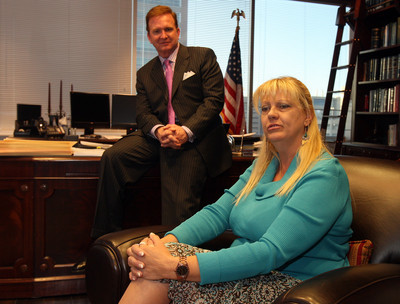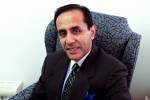Lawyers: Pain, suffering cap won’t bring justice
Just as local trial attorneys begin preparing massive class-action cases against the Endoscopy Center of Southern Nevada, they're running into a potentially big roadblock: a $350,000 state cap on emotional damages in medical-malpractice lawsuits.
The limit applies to compensation for pain and suffering, but it places no restrictions on damages related to medical care, lost wages, living expenses and other direct costs.
Now, lawyers are looking for ways around the pain-and-suffering cap, which Nevada voters approved in a 2004 ballot question.
Robert Eglet, a senior partner in Mainor Eglet Cottle, said his law firm filed several types of claims in two class actions on Monday and Tuesday, as well as a civil case on Wednesday. On top of medical malpractice, Eglet's clients are suing the clinic's operators for fraud, civil conspiracy and negligent hiring, training and supervision. Eglet and other attorneys also are suing for product liability.
A civil-conspiracy case Eglet filed Wednesday includes not just the center's doctors, but also its nurses, physicians' assistants and sister companies. The idea: If lawyers can move claims beyond malpractice alone, they can seek pain-and-suffering damages well beyond the $350,000 cap.
Eglet acknowledged that attempts to avoid the ceiling on emotional damages will be an "uphill battle," but he said justice for his clients demanded the effort.
"Imagine someone who's 25 years old and infected with hepatitis or HIV," Eglet said. "They're going to have to live the remainder of their life receiving treatment and changing their lifestyle. Their pain and suffering, their loss of enjoyment of life -- under current law, (compensation) is capped at $350,000."
Other attorneys and malpractice insurers question the multiple-claims tack. And insurers say attempts to bypass the limit could worsen what's already shaping up to be an epic event in the state's malpractice-liability history.
Richard Harris, managing partner of the Richard Harris Law Firm in Las Vegas, said claims for negligence, fraud or racketeering could push a case beyond the cap. Those claims also could remove a case from the scope of malpractice insurance, he said. That means a doctor's insurer wouldn't be on the hook for damages unrelated to malpractice.
James Marx, president of malpractice insurer Nevada Docs Medical Risk Retention Group, agreed that liability insurance wouldn't compensate patients for claims outside malpractice. The only likely avenue for payouts based on fraud or negligence charges, then, would be through seizing doctors' personal assets.
Eglet said the courts would allow plaintiffs to chase defendants' personal assets if patients win claims that insurance won't cover. Lawyers could perform a "debtors' exam," a deposition designed to pinpoint assets available for satisfying claims.
Larry Matheis, executive director of the Nevada State Medical Society, said it's too early to consider what damages might be available.
"As frustrating as I'm sure this is to lawyers who see a lot of swill in the trough, I think they're just going to have to wait until the facts get clarified and we see just how extensive the risks and actual damages were," Matheis said. "It will be sorted out, but not by public speculation. It's going to be done through a very closely reasoned legal process.
"Nobody has to show restraint here, but everybody should," Matheis added. "The problem is, restraint has gone out the window, and perspective is very difficult to gain. People are trying to answer every question, but answers have to be based on what we actually know."
What trial attorneys know, they say, is that the Endoscopy Center case has proven that doctors will abuse caps on pain and suffering.
When the Legislature passed a bill in 2002 limiting noneconomic damages to $350,000 per malpractice claim, lawmakers carved out two exemptions: gross malpractice and "exceptional circumstances." Doctors, including Endoscopy Center owner Dipak Desai, mounted a ballot initiative that stripped the two exceptions from the law. The end result: no exceptions, and little recourse for patients, attorneys say.
Eglet said he had received around 2,000 calls from consumers by Tuesday afternoon and had signed up "well over" 400 clients. Thirteen of them have tested positive for hepatitis C and one has tested positive for HIV.
Harris also has fielded hundreds of calls a day since the Southern Nevada Health District revealed the results of its investigation at the clinic. He said Tuesday afternoon that he had uncovered at least half a dozen new cases of hepatitis beyond what the health agency had reported.
"Hopefully, this takes the heat off lawyers and puts it back on the medical community, where it belongs," Harris said. "There's absolutely no rhyme or reason to singling out victims of medical malpractice and limiting their damages."
Actually, Marx and Matheis said, important reasons spurred the cap on noneconomic damages.
The potential for unpredictably excessive pain-and-suffering judgments forced malpractice insurers to abandon the Nevada market in 2001 and 2002, Marx said. Doctors who couldn't find liability coverage were packing up and leaving the state, causing acute physician shortages in practice areas such as obstetrics.
The ballot question restored some stability in the world of medical torts, Marx said.
"No one wants to minimize the hardship and anxiety this situation causes, but we really can't put a number on worry and pain," said Marx, who insures only nonsurgical practitioners and has no business relationship with the Endoscopy Center. "If we give an unlimited amount of damages to these patients, someone pays for that. It doesn't come from the insurance company. It's all taken from the doctors. There's a substantial load passed on to doctors, and subsequently to patients, that society has to pay. Someone has decided that $350,000 is reasonable. It's not exorbitant, and it's not minimal."
Matheis agreed, citing a "lottery mentality" that forced up insurance costs in the early 2000s.
Even with limits on pain-and-suffering claims, the Endoscopy Center case, with its 40,000 affected patients, could yield another spike in malpractice rates, Marx said.
Attorneys said they couldn't predict what the total damages might end up being in the case. But Marx noted that some attorneys will attempt to lasso referring primary-care doctors into the case, even if those doctors didn't know about the Endoscopy Center's practices. It's difficult to determine how many claims will emerge.
Just getting a case against a referring doctor dismissed could cost an insurance company $5,000 to $10,000 per doctor, Marx said. For physicians accused of real wrongdoing, legal-defense costs could climb to between $20,000 and $100,000 per case. And that's before you throw in damages.
Because malpractice insurance covers a specific, small pool of just a few thousand doctors, all doctors will feel the result of tens of thousands of patients seeking tens of thousands of dollars in damages each, Marx said.
"It would be foolish to say this won't have any impact on malpractice rates," he said. "As always, the costs are going to be unevenly distributed among people who probably have little, if any, blame in this situation."
Trial attorneys aren't fazed.
"It's a drop in the bucket compared to the industry as a whole and the ability of insurance companies to rebound. This is the same industry that rebounded from Hurricane Katrina and the World Trade Center attacks," Harris said. "Insurance companies rule the world. They've got it figured out to where they can take your money and not give it back."
Contact reporter Jennifer Robison at jrobison@reviewjournal.com or (702) 380-4512.


























